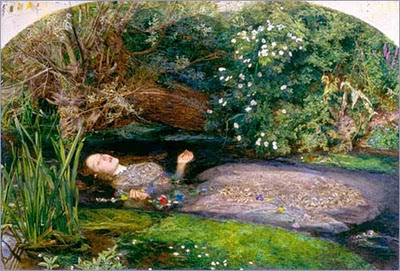I have been neglecting the blog and writing terribly lately, but in the rush up to Christmas things picked up and distraction is not an option, otherwise mistakes occur.
I have to say that they do occur even without distractions, but that's another story.
Talking about University and MA instead, I would like to report here an "exercise" that our tutor gave us:
Choose three artworks and make a show out of it, completed of an exhibition plan.
That is what I came out with and, I must say, I really like the idea of a small, virtual show.
The title would be Falling Slowly, taken from a song:
Take this sinking boat and point it home / We've still got time
Raise your hopeful voice / you had a choice / You've made it now
Falling slowly sing your melody / I'll sing it loud
Glen Hansard, musician
These would be the artworks on display, in an ordinary, four walls room:
 |
| John Everett Millais, Ophelia, 1851 ca, Oil on canvas, 76 x 111 cm |
First one to be seen from the entrance: it's quite a large work and has to make its impact. Not to mention the incredible importance that it had for many future generations of painters, so the spot of honor is definitely for it.
This small photograph goes in front of the Millais. I am very interested in the dialogue between the two mediums, painting and photography. And that is why the third selected work is:
 |
| Lee Miller, Dead SS Guard in Canal, Dachau, Germany 1945 |
 |
| Yigal Ozeri, Priscilla in Ecstasi, 2006, Oil on canvas, 20 x 26 cm |
The text accompanying the show would be this:
The dialogue between the three pieces moves on from the investigated technique to explore the meaning of a fall: according to Eduardo Cycelin, who in turn drew from Deleuze, “falling is the most vivid of sensations, and it is here where one recognizes the feeling of being alive. The staging of death is not its content, but rather indicates the place where the tension of representation is highest and the fall most rapid.”
These look like Apollonian, perfectly represented forms: from the obsessive precision of the Pre-Raphaelite painting to the photograph’s automatic depiction of reality, culminating in the surgical exactness of a painting copied from a photograp; at the same time, they seem to hem in the expression of our Dionysian bestial selves, the intensity of the sensation expressed by gaping, singing mouths and culminating, at the end of the fall, in the self-contemplative silence of death.
It would be nice to hear your opinions: is this a show worth seeing?
John E. Millais’ Ophelia is the depiction of a tragedy: an exceptionally young woman, who was driven crazy by death and loss, lets herself drown while singing until the very last moment. From painting to photograph, Lee Miller’s most famous war reportage picture of a dead SS soldier in Dachau’s canal has often been described by the critics as a contemporary take of the above painting. In the middle, here it stands Yigal Ozeri’s small work: at first sight it does look like another photograph but is, in fact, an incredibly detailed painting; the reprise of Ophelia is, this time, turned from agony to ecstasy, with the techniques of the other two works fused together in a confusing, hybrid result.
The dialogue between the three pieces moves on from the investigated technique to explore the meaning of a fall: according to Eduardo Cycelin, who in turn drew from Deleuze, “falling is the most vivid of sensations, and it is here where one recognizes the feeling of being alive. The staging of death is not its content, but rather indicates the place where the tension of representation is highest and the fall most rapid.”
These look like Apollonian, perfectly represented forms: from the obsessive precision of the Pre-Raphaelite painting to the photograph’s automatic depiction of reality, culminating in the surgical exactness of a painting copied from a photograp; at the same time, they seem to hem in the expression of our Dionysian bestial selves, the intensity of the sensation expressed by gaping, singing mouths and culminating, at the end of the fall, in the self-contemplative silence of death.
It would be nice to hear your opinions: is this a show worth seeing?

No comments:
Post a Comment